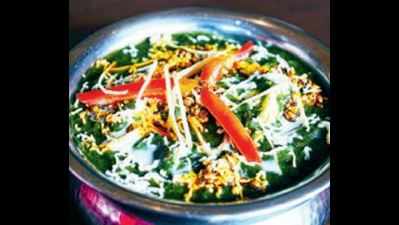- News
- City News
- Hyderabad News
- Poison on your plate: High heavy metal levels found in leafy veggies
Trending
This story is from November 19, 2016
Poison on your plate: High heavy metal levels found in leafy veggies

XLeafy vegetables found contaminated in city.
HYDERABAD: The next time you reach for that lip-smacking plate of ‘Palak Paneer’, ‘Bhaji Gurda’ or ‘Gongura Pachadi’, you might like to ensure that the vegetables used in the dish were not grown along river Musi.
Samples of various types of leafy vegetables collected from farms in the vicinity of the river Musi in Hyderabad and Ranga Reddy districts showed a high concentration of manganese, lead, copper, zinc, iron and cadmium several times more than the permissible daily intake limits.Since these heavy metals have the tendency to accumulate in the body, their levels will keep on increasing over the years.
Spinach or Beta vulgaris with Paneer or potato, Amaranthus (bhaji) with lamb kidney, and pickled Deccan hemp (Gongura) are among the top favourite dishes in Hyderabad. A substantial quantity of leafy vegetables that arrive in markets in Hyderabad are sourced from the farms along the river Musi.
A joint study by researchers from Jawaharlal Nehru Technological University (JNTU) and the Central Research Institute for Dryland Agriculture (CRDA) revealed that the total concentration of these heavy metals was as high as 550.97 mg per kg of spinach and 493.34 mg per kg of Amaranthus. High levels of metal contaminants were also found in other leafy vegetables collected from the farms. Research studies conducted earlier also showed high concentration of dangerous metal pollutants in leafy vegetables grown in the region.
The mid-river course of the Musi is notorious for several types of pollutants including pharmaceuticals and pesticides. They enter into vegetables and fruits through a natural process called bio-accumulation. The concentration of poisonous contaminants varies from farm to farm along the Musi. As part of the study, the researchers collected samples from vegetable farms at Edulabad on the city outskirts, Uppal and Nagole.
“One should consume at least 300 grams of vegetables including the leafy variety every day for good health. If the vegetables contain high levels of contaminants, one will end up consuming four to five times more than the daily permissible limits, which vary from just 35 micro grams in case of cadmium to 10 mg in case of manganese,” said Dr M Khaja, clinical toxicologist.
Toxic Food
Leafy vegetables found contaminated in city: Spinach, Amaranthus, Deccan hemp (Gongura)
Heavy metals amount found in a 200-gram dish made with these vegetables: 110 mg
Daily permissible limit set by WHO: 70 mg
Effects:
Heavy metal poisoning can affect mental health in children
Long-term accumulation in body can even lead to cancer
Precautions
Soak vegetables in water for a long time and then wash them thoroughly
Samples of various types of leafy vegetables collected from farms in the vicinity of the river Musi in Hyderabad and Ranga Reddy districts showed a high concentration of manganese, lead, copper, zinc, iron and cadmium several times more than the permissible daily intake limits.Since these heavy metals have the tendency to accumulate in the body, their levels will keep on increasing over the years.
Spinach or Beta vulgaris with Paneer or potato, Amaranthus (bhaji) with lamb kidney, and pickled Deccan hemp (Gongura) are among the top favourite dishes in Hyderabad. A substantial quantity of leafy vegetables that arrive in markets in Hyderabad are sourced from the farms along the river Musi.
A joint study by researchers from Jawaharlal Nehru Technological University (JNTU) and the Central Research Institute for Dryland Agriculture (CRDA) revealed that the total concentration of these heavy metals was as high as 550.97 mg per kg of spinach and 493.34 mg per kg of Amaranthus. High levels of metal contaminants were also found in other leafy vegetables collected from the farms. Research studies conducted earlier also showed high concentration of dangerous metal pollutants in leafy vegetables grown in the region.
The research team that included G Anil and ES Priya suggested that samples should be collected at regular intervals for assessment and monitoring of the levels of heavy metal contaminants along the river Musi.
The mid-river course of the Musi is notorious for several types of pollutants including pharmaceuticals and pesticides. They enter into vegetables and fruits through a natural process called bio-accumulation. The concentration of poisonous contaminants varies from farm to farm along the Musi. As part of the study, the researchers collected samples from vegetable farms at Edulabad on the city outskirts, Uppal and Nagole.
“One should consume at least 300 grams of vegetables including the leafy variety every day for good health. If the vegetables contain high levels of contaminants, one will end up consuming four to five times more than the daily permissible limits, which vary from just 35 micro grams in case of cadmium to 10 mg in case of manganese,” said Dr M Khaja, clinical toxicologist.
Toxic Food
Leafy vegetables found contaminated in city: Spinach, Amaranthus, Deccan hemp (Gongura)
Heavy metals amount found in a 200-gram dish made with these vegetables: 110 mg
Daily permissible limit set by WHO: 70 mg
Effects:
Heavy metal poisoning can affect mental health in children
Long-term accumulation in body can even lead to cancer
Precautions
Soak vegetables in water for a long time and then wash them thoroughly
End of Article
FOLLOW US ON SOCIAL MEDIA











